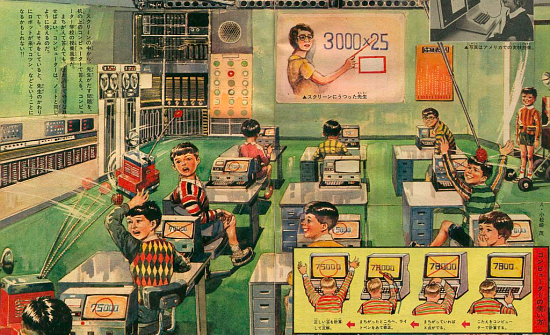Can Machines Replace Teachers in Education Systems?

Does this statement make you cringe? Squirm a bit in your chair? I’m not surprised if it does. As access to technology proliferates among schools in developing countries, a call for improved teacher training, curriculum, and methods of assessment seems vital to ensuring that the initiatives are sustainable. How else can you ensure that children are using time spent on a computer effectively and for educational purposes?
Despite this logical breakdown, research conducted in India over the past decade disputes these views. Let me preface an explanation of this research with a brief story:

By the time I reach the students at the last computer, I am quite surprised to find that, not only have they completed the assignment on their own, but the desktop background has also been changed from the image of green hills to a Black Labrador dog. Awestricken at these novice geniuses, I ask the students, “How did you do that?” With each student chiming in his or her own input, they navigate their way back through the steps to where they changed the image. I’m so impressed that I do not bother reprimanding for not following instructions.
This story illustrates New Dehli researcher, Sugata Mitra’s, suggestion that students using technology in unstructured, self-organized groups can help each other guide their own learning. In 1999, Mitra began experimenting with educational technology by building a PC with a high-speed internet connection into a wall in the slums of New Delhi. He then left the computer with no instructions for use or devices for language translation, planning to observe how individuals interacted with it.
Soon two children were huddled around the computer. Within minutes they had taught themselves how to point and click and were browsing the internet by the end of the day. After repeating this “Hole in the Wall” experiment throughout rural communities in India, he came to the conclusion that children, living in areas that lack adequate resources for instruction, could teach each other how to use a computer by working together in groups.
He makes several arguments for the benefits of this type of learning in classrooms:
- It reduces the costs of efforts such as One Laptop per Child. While Mitra supports the design of the laptop, he believes there should be one laptop for every four children so that groups can work through their setbacks together.
- When children are learning technology and exploring interests in an unstructured setting, they become excited about learning and retain much more.
- Expecting children to work through the dilemmas on their own teaches them innovation and creative problem solving, two skills essential to any job. Instead of producing students that are able to memorize a laundry list of items, this approach produces students that know how to pinpoint where to find the same information.
- Having children work together in groups teaches teamwork and collaboration.
I do not doubt that there is a place for Mitra’s recommendation of self-organized group learning in ICT4Ed. It’s a great opportunity for students to explore their curiosities, learn skills in innovation and problem solving, and retain steps to a much greater extent than they can with rote memorization.
However, I do believe that it is important to discern an appropriate time and circumstance for this method of learning. For instance, providing students with an allotment of time each day to freely roam the internet together, researching topics of their own interests, could be a great opportunity to keep them excited about technology and to show them how they can find answers to pressing questions and work through problems on their own.
This, however, can not replace the role of a teacher and a curriculum. Knowing how to use the tools for gathering information is an excellent skill but will not help a student requiring computer knowledge at a time when tools are not at hand. Following a structured curriculum ensures that students have the foundation of fact-based information to make them productive even when technology is not readily available. Furthermore, it ensures that all students are participating and learning the skills that they will need.
To illustrate these points, let’s look at back at my story and point out some of the gaps:
- All of the students may now remember exactly how to change a desktop background. This does not mean, however, that they know how to verbalize the steps that they took without the computer screen directly in front of them. If someone were to ask one of the students to write down the steps, the student would not know the terms needed to describe the steps discernibly. Having a solid, curriculum-based foundation in educational technology and being assessed on it without a computer screen makes a student much more productive in times when technology is not available.
- Students may have worked together to describe their steps to me, but this does not account for the one student, towards the back of the group, that is not paying attention or contributing to the group’s input. Having teachers and providing assessments can make sure that all students are gaining knowledge, not just the ones that put forth the most effort.
- Changing a computer background may have been a great lesson working through computer screens to bring about a change on the computer, but it is not much of a useful skill in technology. If computer instruction consists of students roaming about the computer, exploring their interests, there will be quite of bit of pertinent information that they will likely not take the time to learn on their own. Making the desktop background look pretty is much more interesting to a student than learning the difference between RAM and ROM or how a file system works. These are skills that are important, so it is necessary to have a curriculum in place.
Taking this into consideration, while Sugata Mitra sets forth an interesting model for student learning that may have a place during a fraction of the school day, teachers, curriculums, and assessments cannot be replaced by machines and curious children.
![]()






































